
Original Link: https://www.anandtech.com/show/2342
The Business of Technology: Creative Labs
by Ryan Smith on October 2, 2007 5:00 PM EST- Posted in
- Bulldozer
Business and technology are forever linked together in one inseparable mass. Technology drives business: it drives new products, it drives improvements in efficiency, it drives companies out of business. Business drives technology: it drives what gets researched, it drives what gets invented, it drives the pace of technological progress. Each drives the other, the feedback from each further changing how one or the other progresses.
One only needs to look as far as the CPU industry to get an idea of just how this works. Intel has a strong business that keeps the company floating when one or more aspects of their technology portfolio are faltering, and having such wealth buys them technology advantages such as smaller processes sooner. Meanwhile AMD has a strong technology portfolio that keeps the company going even when business is bad, putting the company years ahead of Intel in in areas like the server market. Here the dynamic duo of HyperTransport and the Integrated Memory Controller have kept the company ahead of the Core2's onslaught over the past year (and will continue at least until Nehalem arrives).
It's because of the intertwined nature of business and technology that we sometimes have trouble conveying the whole situation when trying to talk about technology; some things can't make sense without an understanding of the business situation too. In recognition of that we are starting a new series "The Business of Technology," looking at companies and their technology from the side of business instead of the side of technology. From this perspective we can comment on things when it's not possible to do so from the technology side, and come to a better understanding on how for the companies we cover their business and technology situations are both driving their future.
Bear in mind that this is new ground for us, and how we go about things in the future will no doubt change with the times. We'd like to hear back from you, our readers, on how informative you find this approach, and how we can better deliver information from it. We'd like to bring everything to you in a well-rounded when possible.
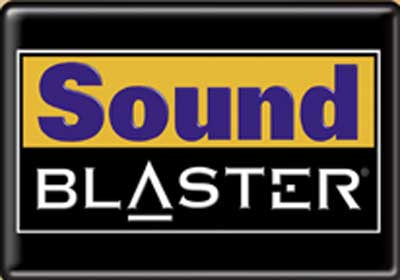
The brand that started it all
With that out of the way, we're starting this series with Creative Technology Ltd, better known as Creative Labs. Creative has a long and rich history, the culmination of which was the creation of the SoundBlaster line of sound cards and the associated audio standard, which brought the full spectrum of synthesized and recorded audio to the PC. Although they have since expanded in to many other markets, Creative has and continues to be primarily a sound company, and was the king of sound cards... until recently.
Creative by The Numbers
We'll start with Creative's financial/business situation first, as it will help us paint the picture of their overall health and market status.
Creative first went public in 1992, listing their shares on the NASDAQ stock exchange. It's important to note however that Creative is not an American company but rather a Singapore company; so the NASDAQ listing was followed 2 years later with a listing on the Singapore Exchange, a result of their desire to tap the richer American IPO market. Creative Labs as we commonly refer to them by is actually the American subsidiary of Creative Technology Ltd.
If a stock is the best way to measure the health of a company, then Creative is about as sick as they come. Creative's lowest stock price ever was in 1996, where the stock hit a mid-day price for three days straight of $3.50, closing slightly higher than it each time. Following that low point Creative has seen numerous high-flying years, since then, peaking at nearly $40 in 2000. However the good times for Creative took a hit following the general economic downturn of 2001 and the company has never quite recovered. This has culminated in a near-continuous slide since the start of 2005, and nearly 3 whole years later the company's stock price is now flirting with the all-time low. On August 22nd of this year they briefly traded at $3.58, a mere $0.08 above their all-time low. Although they are now back up above $4 at $4.08, by this standard Creative is still in very, very poor shape.
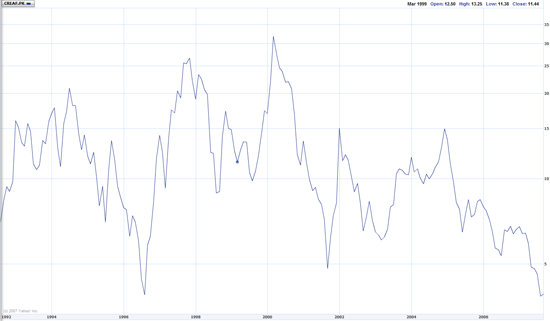
Stock history courtesy of Yahoo! Finance
Furthermore as of the start of September, Creative has ceased listing its stock on the NASDAQ, now focusing on trading it exclusively over the Singapore Exchange, with some trading still taking place as Over The Counter trades in the United States. Creative has cited the reason for the move as being two things: 1) Most of the trading of the stock these days is done over the Singapore Exchange making the NASDAQ listings redundant and 2) They were dissatisfied with the reporting requirements for companies listed on American exchanges, which requires a level of detail and work not required for the Singapore Exchange. In other words, the reporting requirements enforced upon them to be listed on the NASDAQ weren't worth the limited trading business it was bringing them. To be fair to Creative, this announcement was made on June 14th, more than two months before they scraped the bottom, but it still has happened at a bad time for them.
To understand why their stock price is so low, we'll next take a look at their revenue, which for obvious reasons greatly influences their stock price. Creative uses a modified fiscal year calendar, with their fiscal year ending on June 30th of the year (the end of the second quarter on the traditional calendar). For the 4th quarter of fiscal year 2007 (Q4FY07, aka Q2'07) final quarter they had a revenue of $165mil, with an operating expense of $183mil, putting them in the red for the quarter to the tune of $18mil. After other income and losses (taxes, interest, etc) they lost just shy of $20mil for the quarter.
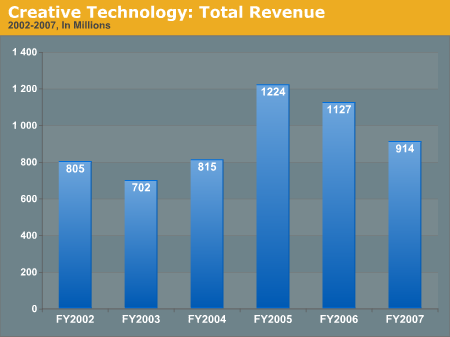
Their entire year is a brighter story, with revenue of $915mil and a final net income of $28mil. However these numbers look better for Creative than they actually are, due to the fact that in FY2007 they received a very large one-time payment for $100mil. In 2005 Creative was awarded a user interface patent for MP3 players, they promptly turned around and went after Apple with it, as Apple controls the lion's share of the MP3 player market. In August of 2006 Apple and Creative settled the matter with Apple paying Creative $100mil to drop all legal suits against Apple (with Steve Jobs saying "Creative is very fortunate to have been granted this early patent").
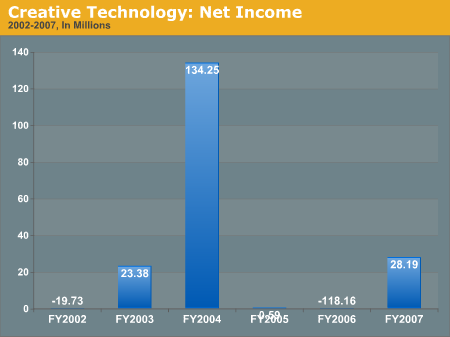
It's because of that $100ml payment that Creative was able to turn a profit for FY2007, and while we can't calculate what their exact income would have been for FY2007 without it, all other things held the same they would have had a sizable loss for the year. We would need to go back to FY2004 to find the last time Creative turned a real profit, when that year they pulled in $134mil. FY2005 was effectively break-even with a very slight profit of $590,000, and FY2006 saw a loss of a massive $118mil. This roughly correlates with Creative's stock price slide; they haven't turned a significant profit since FY2004 and haven't seen their stock price go up for any significant period of time since January 2005. As a result, at this point Creative is by no means destitute, thanks in large part to their settlement with Apple, but the immediate outlook isn't good, with no immediate sign that they'll be able to turn a profit in the near future.
Wrapping up Creative's financial situation, Creative includes some very interesting statistics with their fiscal reports: revenue as a share of location, and revenue as a share of product type. If you're in the Americas and you've ever felt that Creative doesn't seem very active here, you're not alone; the percentage of revenue coming from the Americas has shrunk over the past year from nearly half of all of Creative's revenue (46%) to less than a third (30%). Europe is now Creative's largest source of revenue at 47%, and Asia rounding things out at 23%.
As for the product situation, Creative has for years relied on portable media players for the majority of its revenue. This peaked in the later part of 2006, where such devices were 70% of their revenue, while this has since dropped a bit to 57% as of the end of Q4FY07. This market has a large reliance on new product releases making it volatile, but it still represents a general trend for Creative in the reduction of revenue coming from portable media players. No other product segment from Creative is nearly as big; audio, speakers, and everything else are all fairly close in size, although Creative is going to have to rely on these more and more as their portable media player revenue continues to slide.
| Revenue By Geographical Region | |||
| Q4FY2007 | Q3FY2007 | Q4FY2006 | |
| Americas | 30% | 32% | 46% |
| Europe | 47% | 49% | 37% |
| Asia & Other | 23% | 19% | 17% |
| . | |||
| Revenue By Product Category | |||
| Q4FY2007 | Q3FY2007 | Q4FY2006 | |
| Portable Media Player | 57% | 52% | 65% |
| Audio | 15% | 17% | 13% |
| Speakers | 18% | 21% | 13% |
| Other | 10% | 10% | 9% |
| . | |||
Creative's Technology
So what has brought upon these changes in revenue and Creative's overall business problems? The answer to that lies in what's been going on with their technology and individual product market share.
Earlier we called Creative the king of sound cards until recently, much of their business woes stems from that loss. Creative's history is one founded on the back of the Sound Blaster hardware and the Sound Blaster name, creating a problem for Creative in having all of their eggs in one basket that they have been trying to solve for years. All told, Creative hasn't had a lot of luck spreading out their business and doing well; various efforts like graphics cards and DVD-ROM drives never panned out. Of the few things that have panned out, Creative's major consumer product lines have settled in as the following: portable media players, sound cards, webcams, and speakers.
Since sound cards were Creative's biggest business at one point, it has been Creative's biggest loss. Onboard audio has gone from a joke 10 years ago to how the vast majority of computers today handle audio, and it has been Creative who has suffered the greatest losses from that. The Live and Audigy series have both been bonafide successes in terms of sales, but never the less sales are slowing and the X-Fi likely won't be nearly as successful. The fact of the matter is that the consumer sound card market is on its last leg and the possible user base for such hardware has shrunk to professionals and gamers, and that's it.
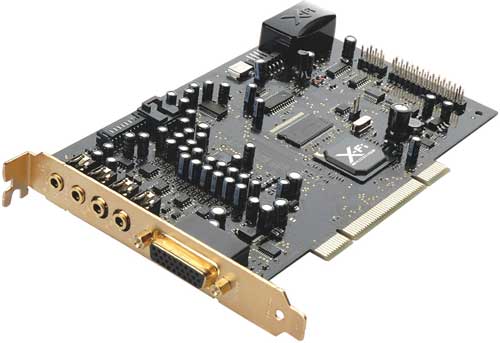
The X-Fi will likely be the last significant feature-heavy sound DSP to be released by anyone, and it will never match the kinds of sales Creative has seen with earlier products. The final nail in the coffin will be Windows Vista, which as we have discussed in our review of that operating system, under normal circumstances runs the entire audio subsystem in software, reducing the need for a sound card down to a DAC to handle the digital/analog conversion. Creative's own troubles in writing solid Vista drivers for their sound cards hasn't helped matters either, but this has only hastened the inevitable. The sound card is dead, and it isn't coming back.
So what is Creative's leading product with the demise of the sound card? As we saw in their financials, it's now portable media players, a growing market but unfortunately for Creative it's one that they're getting slaughtered in. Prior to the arrival of the iPod, Creative was vying for the top of the portable media player market next to the now-defunct Rio brand, leading to the infamous Slashdot quote about the iPod's release: "No wireless. Less space than a nomad. Lame." Now Creative is struggling in a market where it was one of the first players.
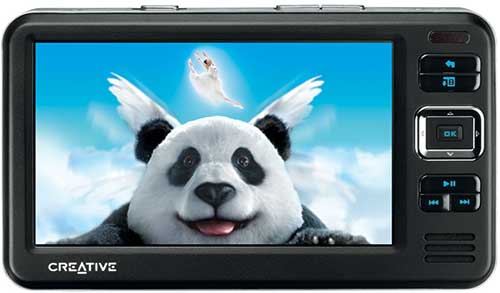
Apple has the vast majority of the North American market for obvious reasons, but #2 tends to be shocking to most people: SanDisk. With Apple's main focus on the mid-to-high end MP3 player market, it has left an opening for cheap media players that SanDisk has been able to fill. Meanwhile both SanDisk and Apple have kept Creative and the other competitors locked out of the market, with Creative taking the #3 spot with less than 4% of the market. Creative's problems are further compounded by Microsoft at #4, who is more than happy to lose money on the media player market for now, and previously backed the PlaysForSure technology that Creative uses for DRM. It should be noted however that Apple doesn't have this kind of penetration in Asia, but as there are no reliable statistics on sales in most Asian markets, we can't ascertain what Creative's exact share there is, but it's believed to still be well below #1.
As a result of all of this, what little share of the market Creative has is almost entirely composed of the near-commodity market, save the small number of "anything but Apple" sales. Their Nomad and Zen lines do not have any significant brand recognition, meanwhile SanDisk can build & sell flash based media players for less than Creative. What little bit of the near-commodity market Creative does have a strong foot in is hard drive based media players that focus on video, and even this is at risk of being undermined by Apple now that they have a full-screen iPod to compete. In spite of all of this the majority of Creative's revenue comes from portable media player sales, but fighting on the near-commodity market means they will never be able to attain much of a profit with it.
Creative's third market segment, webcams, is more or less the same story. Webcams are a commodity - there's a lot of competition and not a lot of money. They may stay in it, but they'll never be able to repeat their most profitable days relying on webcams.
There is one bright spot for Creative however, and that's speakers. In their efforts to branch out Creative picked up Cambridge Soundworks in 1997, and their speaker division has continued to perform well. Creative is only dealing in computer speakers which limits their overall market and they face stiff competition from the likes of Logitech, but this market isn't quite a commodity market like Creative's other major markets. In fact as a percentage of revenue the speaker division is nearly 20%, which is itself nearly twice as much as it was 2 years ago. We'd expect Creative to be pushing their speaker products harder as the sound card market finishes crashing, since even with the integration of audio consumers still need speakers.
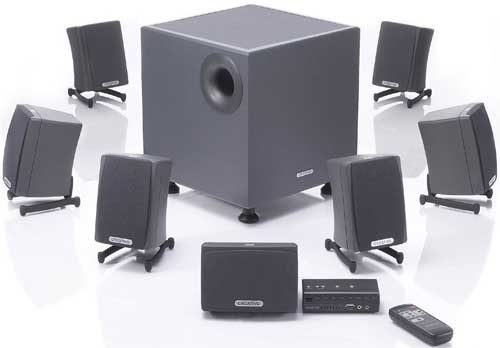
Finally there are all of Creative's other markets, which we'll touch on briefly. Creative continues to sell various peripherals, such as mice and routers, but most of these are low-volume products that are simply rebranded products form other suppliers. In fact most readers have probably never seen these products in a local store; Creative's minor product lines are almost exclusively limited to the Asian markets. The profitability from these operations is reportedly decent, but it's not something that Creative can win at in the international markets.
Closing Thoughts
So between their business and technology, where does all of this leave Creative? Simply put, it would be difficult to argue they're not in a very bad situation.
On the technology side, almost all of their markets are either commodities or dying, and they're not the market leader in anything any more. Some businesses exist and thrive solely as a supplier of commodity components, but Creative isn't that kind of company. They need to be able to take a major part in a new high-profit industry to replace what they've lost from the sound card market, and they've yet to find something that can sustain them for long. Or to put things in another perspective: we don't see them as having the technology needed to carry the company.
On the business side, they're already in trouble from their technology issues. Their stock price is near record lows and they haven't been able to generate enough revenue to cover costs in a couple of years. Their saving grace at the moment is their Apple settlement, which has helped them turn a profit for this year at least. In the next year or so they may be able to take a piece of flesh from all the other major portable media player competitors, but there's a finite number of targets and as one-time payments the money won't last forever. For the time being Creative's business side can hold up the company, but it can't do this for very long, they need improvements on the technology side to bring the company back in to balance.
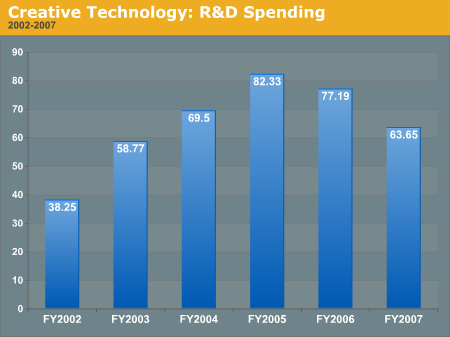
Looking at their research & development expenditures however, it paints a conflicting picture. A company in need of technological rejuvenation generally needs to be spending a lot on R&D, and this isn't the immediate case. FY2007 R&D spending was $64mil, compared to $77mil the year before and $82mil the year prior to that. We would have to go back to FY2003 to find a time they spent less on R&D, and that was one of their boom years. $64mil is not a small chunk of change to be spending on R&D (it's some 7% of all revenue) but it still leaves us wondering if they're going to be able to develop something to get the company out of its current rut. R&D spending only gets harder as revenue continues to drop.
In closing, it's too early to even be hinting at doom & gloom for Creative yet, but by now the first warning light has lit up. Things are not good for Creative right now, but there's a lot of time left. But can the company survive the dramatic shift required to make it? Only time will tell.







